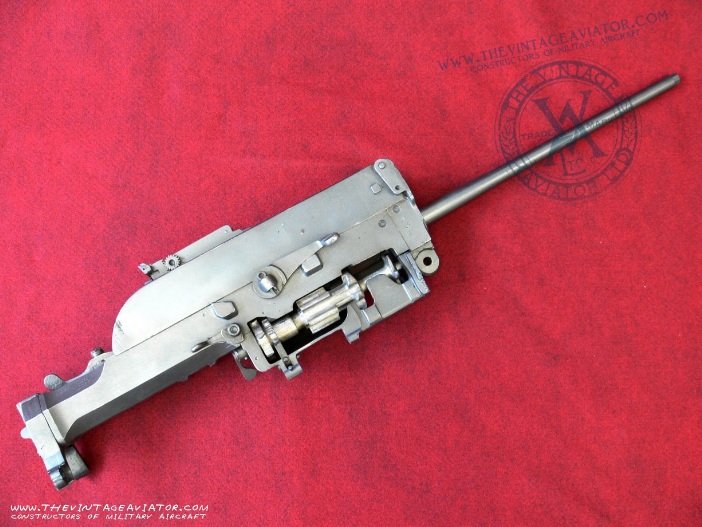A pointed account of the Schwarzlose M1907 aircraft machine gun, from John Biggins’ hilarious description of the Austro-Hungarian Empire in WWI, The Two-Headed Eagle (The Otto Prohaska Novels):
The 8mm Schwarzlose had been the Austro-Hungarian Army’s standard machine gun since 1906 or thereabouts, selected after an exhaustive series of competitive trials in which it alone had been able to meet the War Ministry’s stringent specification as regards price. I suppose that the thing might have been just about adequate for a peacetime army, but for fighting a World War it was a very dubious contraption indeed. Whereas most other machine guns in service around the world were operated by muzzle-gas, Herr Schwarzlose had chosen to make his design work by recoil – and had then (for some quite unaccountable reason) decided to dispense with the locking system generally considered necessary to hold a machine gun breech shut while each round is fired These twin eccentricities meant that the Schwarzlose had to have a very short barrel – and thus mediocre range and accuracy, not to mention a picturesque gout of flame as each round left the muzzle.
It also necessitated a massive breech block, like a miniature blacksmith’s anvil, so that its inertia would prevent it from being blown back into the gunner’s face. This in its turn meant a further loss of range, because so much of the energy from each shot was absorbed in kicking the breech open. As a result its rate of fire was poor: about four hundred shots per minute on paper but barely three-quarters of that in practice.
And that was just the army version: the air Schwarzlose, which now rested behind me on its rails ready for action, was a still further declension of mediocrity. Unlike the excellent Parabellum – standard observer’s gun in the German two-seaters – it had no shoulder-stock to allow the gunner to keep his aim however violently the pilot was throwing the aeroplane about the sky. Instead it had a pair of handles like those of a child’s toy scooter. The water-jacket bad been removed to save weight; but this had only made the aim even more uncertain since it abolished the foresight and also meant that we could fire bursts of only twelve or so shots at a time, for fear of burning the barrel. As for the ammunition feed, it consisted of a canvas belt of five hundred rounds coiled in a metal drum on the side of the thing. This belt would always absorb some damp in the early mornings, waiting out on the airfields, and even in summer this would often freeze in the upper air, causing the gun to jam. This was bad enough, but our gun that morning was an early model – pensioned off no doubt from the Army – in which each cartridge had to be lubricated by a little oil-pump as it went into the breech so that the empty case would extract afterwards. This oil would become sticky in the cold, so that even if the gun would still fire it would slow down to two hundred rounds or so per minute, making it sound like an exhausted woodpecker on a hot summer’s afternoon. All things considered, I think that a Singer sewing machine would have been about as much use for defending ourselves – as well as being a good deal lighter.
Certainly inspires confidence, doesn’t it? We have more information on the Schwarzlose that we’ll be posting later this week.

(photo swiped from The Vintage Aviator, a fantastic site on WW1 aircraft)


Thanks. I’ll have to look those novels up.
Thanks! I read one of John Biggins’ Otto Prohaska series, and must say it was a very fun reading!
Was the gun really that bad???
I think we have access to one – we’ll have to take it out to the range and find out. 🙂
Now I know why the dutch army used them up to ww2!
Yep, they were, in fact, the cheapest machine guns you could buy.
Swedish army used Schwarzlose as well (they had set up licensed production at Carl Gustaf), and I believe they knew a lot about using weaponry in cold climate.
One plus about Schwarzlose is taht it was really simple design, compared to contemorary wonder machines like Maxim
I think the wording of the text proves beyond any doubt the total incompetence of the author in this subject.
@JPeelen- You do recognize that the so-called “assessment” is an excerpt from a novel and as such is not meant to be a serious technical review? Is it your contention that the Schwarzlose didn’t behave in the manner described when deployed in an aircraft?
When someone describes the breechblock of a weapon as a “minature blacksmith’s anvil” he is obviously not interested in facts, has no knowledge about firearms and no knowledge about blacksmith’s anvils. My father was a blacksmith.
So, whatever he writes, it cannot be taken seriously.
Perhaps you’re taking it a bit too seriously?